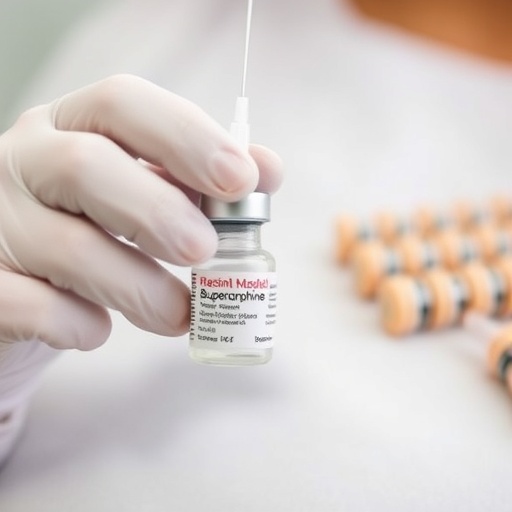Recent advancements in opioid addiction treatment underscore a significant shift in how healthcare systems are addressing the growing crisis. Long-acting injectable formulations of buprenorphine have emerged as a powerful tool in this effort, offering a potential solution that not only optimizes patient care but also reduces the need for inpatient services. A recent study conducted by Gauffin et al. sheds light on how the introduction of this innovative treatment has led to positive outcomes for patients grappling with opioid dependency.
Historically, the opioid crisis has plagued many countries, leading to devastating consequences for individuals, families, and healthcare systems. Traditional treatment methods, which often involved regular outpatient visits for medication management, struggled to keep up with the escalating need for effective interventions. In this context, long-acting injectable buprenorphine presents a game-changing option. By providing a steady release of medication over an extended period, this treatment minimizes the frequency of dosing, thereby improving adherence and overall outcomes.
The study, featured in BMC Health Services Research, demonstrates a compelling correlation between the introduction of long-acting injectable buprenorphine and a noticeable reduction in inpatient care requirements. This finding is particularly significant for healthcare providers who have long sought to balance effective addiction treatment with the need to conserve healthcare resources. The study’s comprehensive approach, analyzing patient records before and after the implementation of this treatment, underscores the potential benefits of reducing the burden on inpatient facilities.
One of the primary advantages of long-acting injectable buprenorphine is its ability to offer patients a more manageable and flexible treatment regimen. In contrast to traditional oral medications that require daily dosing, the long-acting formulation can be administered monthly or even quarterly, depending on the individual patient’s needs. This flexibility not only eases the logistics of treatment for patients but also allows them to engage more fully in their everyday lives, which is crucial for those trying to rebuild after addiction.
Furthermore, the reduction in the need for inpatient care aligns with a broader trend in healthcare to move towards outpatient and community-based solutions. By keeping patients out of hospital settings, healthcare systems can allocate resources more effectively and prioritize preventive care. This shift is essential in a landscape where overcrowding in hospitals often leads to diminished quality of care, particularly for complex conditions like substance use disorders.
The implications of this study extend beyond the immediate benefits of reduced inpatient care. Long-acting injectable buprenorphine also represents a significant advancement in how medical professionals view opioid dependence. By shifting the focus from mere management of symptoms to holistic recovery strategies, healthcare providers can foster an environment that promotes long-term health and well-being for individuals battling addiction. This evolution in treatment philosophy has the potential to redefine the trajectory of recovery for countless individuals.
Additionally, the study emphasizes the importance of individualized treatment plans. Buprenorphine’s unique pharmacological properties allow healthcare providers to tailor treatments to the specific needs of each patient. This personalized approach recognizes that addiction is not a one-size-fits-all condition; it requires nuanced strategies that take into account the patient’s medical history, psychosocial factors, and treatment goals. As a result, long-acting injectable buprenorphine aligns well with contemporary trends in medicine that prioritize personalized care.
While the findings of Gauffin et al. are promising, they also open the door to further inquiries in the field of addiction treatment. Future research is essential to explore how long-acting injectable buprenorphine interacts with various demographic factors and which patient populations benefit most from its use. Understanding these dynamics will be crucial in ensuring that the treatment is accessible and effective for all who need it.
Moreover, integrating long-acting injectable buprenorphine into existing treatment frameworks necessitates appropriate training for healthcare providers. Clinicians must be equipped with the knowledge and skills to manage this therapy effectively and to counsel patients regarding its use. Education around potential side effects, contraindications, and the overall philosophy of care will strengthen the deployment of this innovative treatment option.
As healthcare systems grapple with the ongoing realities of opioid addiction, the insights from this study offer a beacon of hope. The success of long-acting injectable buprenorphine in reducing inpatient needs could inspire broader acceptance and utilization of similar innovative therapies. This progress is vital as communities strive to address not only the symptoms of addiction but also its root causes, fostering resilience and recovery among those affected.
Public health campaigns aimed at raising awareness about the availability and benefits of long-acting injectable buprenorphine can further enhance its adoption. Efforts to inform both patients and healthcare providers about this treatment option will be essential in reducing stigma and facilitating access to care. By empowering individuals with knowledge and resources, public health initiatives can catalyze a cultural shift in how society perceives and addresses addiction.
In conclusion, the introduction of long-acting injectable buprenorphine marks a critical advance in the treatment of opioid dependency. The study by Gauffin et al. reinforces the notion that innovative treatment modalities can lead to substantial improvements in patient care and resource management within healthcare systems. As this field continues to evolve, it holds the promise of a more compassionate and effective approach to one of the most pressing health crises of our time.
The transition towards longer-lasting alternatives in opioid addiction treatment not only builds a pathway to recovery for many but also lays the groundwork for a systemic change in how we perceive and act on addiction. The hope is that as awareness grows, the stigma surrounding opioid use disorder will diminish, paving the way for a future where recovery is not only possible but sustainable.
As dialogue promotes understanding and acceptance, the health sector stands on the brink of a transformative era. With research-backed strategies like long-acting injectable buprenorphine at our disposal, we can collectively strive toward a healthier tomorrow for individuals and communities impacted by the opioid crisis. The promising findings of reduced inpatient care requirements serve as a vital reminder that effective, compassionate treatment is within reach, affirming the belief that recovery is not just a dream but an achievable reality.
Subject of Research: The impact of long-acting injectable buprenorphine on the need for inpatient care in opioid dependency treatment.
Article Title: Reduced need for inpatient care following introduction of long-acting injectable buprenorphine.
Article References: Gauffin, E., Marques Franca, A., Pizzaro Ferrero, E. et al. Reduced need for inpatient care following introduction of long-acting injectable buprenorphine. BMC Health Serv Res 25, 1397 (2025). https://doi.org/10.1186/s12913-025-13607-7
Image Credits: AI Generated
DOI:
Keywords: Opioid addiction, buprenorphine, long-acting injectable, inpatient care, treatment efficacy, addiction recovery.
Tags: buprenorphine effectiveness in opioid dependencyhealthcare systems response to opioid crisisimproving adherence in opioid treatment programsinnovative addiction therapieslong-acting injectable buprenorphinemedication management in addiction treatmentopioid addiction treatment advancementsopioid dependency treatment outcomesoutpatient versus inpatient addiction carepatient care optimization strategiesreducing inpatient care needsstudy on buprenorphine impact






